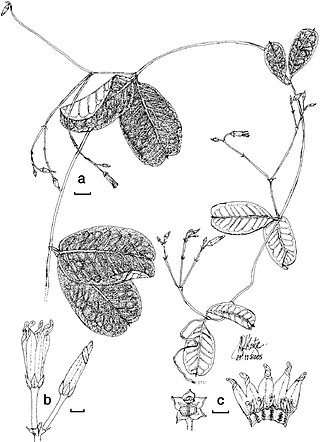
The Asclepiadoideae are a subfamily of plants in the family Apocynaceae. Formerly, they were treated as a separate family under the name Asclepiadaceae, e.g. by APG II, and known as the milkweed family.

Stapeliinae is a subtribe of flowering plants within the subfamily Asclepiadoideae of the family Apocynaceae. The subtribe comprises about 35 genera, including both the stem-succulent "stapeliads" and the horticulturally popular genera Brachystelma and Ceropegia. The largest number of genera are native to Africa, but a more limited number of genera are widespread in Arabia and Asia.

Cynanchum is a genus of about 300 species including some swallowworts, belonging to the family Apocynaceae. The taxon name comes from Greek kynos and anchein, hence the common name for several species is dog-strangling vine. Most species are non-succulent climbers or twiners. There is some evidence of toxicity.

Oxypetalum is a genus of flowering plants in the family Apocynaceae, first described with this name in 1810. The genus is native to South America.

Vincetoxicum is a genus of plants in the family Apocynaceae. Although the species in Vincetoxicum have sometimes been included in Cynanchum, chemical and molecular evidence shows that Vincetoxicum is more closely related to Tylophora, now included in Vincetoxicum. The generic name means "poison-beater" in Botanical Latin because of the plants' supposed antidotal effects against snakebite.

Cryptolepis is a plant genus in the family Apocynaceae. It includes some 42 species.
Sacleuxia is a genus of flowering plants in the family Apocynaceae. It is also in the Periplocoideae subfamily.

Periploca is a genus of plants in the family Apocynaceae, first described for modern science by Linnaeus in 1753. It is native to Europe, Asia, and Africa.
- Periploca aphyllaDecne. - Middle East from Sinai to Pakistan
- Periploca calophylla(Wight) Falc. - S China, Nepal, Bhutan, Assam, E Himalayas, Vietnam
- Periploca chevalieriBrowicz - Cape Verde Islands
- Periploca chrysanthaD.S. Yao, X.D. Chen & J.W. Ren - Gansu Province in China
- Periploca floribundaTsiang - Yunnan, Vietnam
- Periploca forrestiiSchltr. - Guangxi, Guizhou, Qinghai, Sichuan, Tibet, Yunnan, India, Kashmir, Myanmar, Nepal
- Periploca graecaL. - Mediterranean
- Periploca hydaspidisFalc. - Kashmir
- Periploca laevigataAiton - Canary Islands, Savage Islands
- Periploca linearifoliaQuart.-Dill. & A. Rich - Ethiopia
- Periploca nigrescensAfzel. - W Africa
- Periploca refractifoliaGilli - Tanzania
- Periploca sepiumBunge - widespread across much of China
- Periploca tsiangiiD. Fang & H.Z. Ling - Guangxi Province in China
- Periploca visciformis(Vatke) K. Schum. - Somalia

Rauvolfioideae is a subfamily of the flowering plant family Apocynaceae. Many species are woody lianas, others are shrubs or perennial herbs.

Secamonoideae is a subfamily of the dogbane family, Apocynaceae.

Pachycarpus is a genus of plants in the family Apocynaceae, first described in 1838. It is native to Africa.
Pentopetia is a plant genus in the family Apocynaceae, first described as a genus in 1844.

Tacazzea is a genus of plants in the family Apocynaceae, first described in 1890. It is native to Africa.

Raphionacme is a plant genus in the family Apocynaceae, first described as a genus in 1842. The genus is found primarily in Africa, with one species on the Arabian Peninsula.
Chlorocyathus is a genus of plants in the Apocynaceae, first described in 1887. It is native to southern Africa.
- Chlorocyathus lobulata(Venter & R.L.Verh.) Venter - Bathurst District in Cape Province of South Africa
- Chlorocyathus monteiroaeOliv. - Maputo Bay in southern Mozambique

Mezoneuron is a genus of flowering plants in the legume family, Fabaceae. It belongs to the subfamily Caesalpinioideae and the tribe Caesalpinieae.

Cryptolepis africana is a species of plant in the Apocynaceae family. It is native to Kenya. Arthur Allman Bullock, the botanist who first formally described the species, using the synonymous subspecies name Cryptolepis sinensis subsp. africana, named it after the location where the sample he examined was collected in East Africa.














